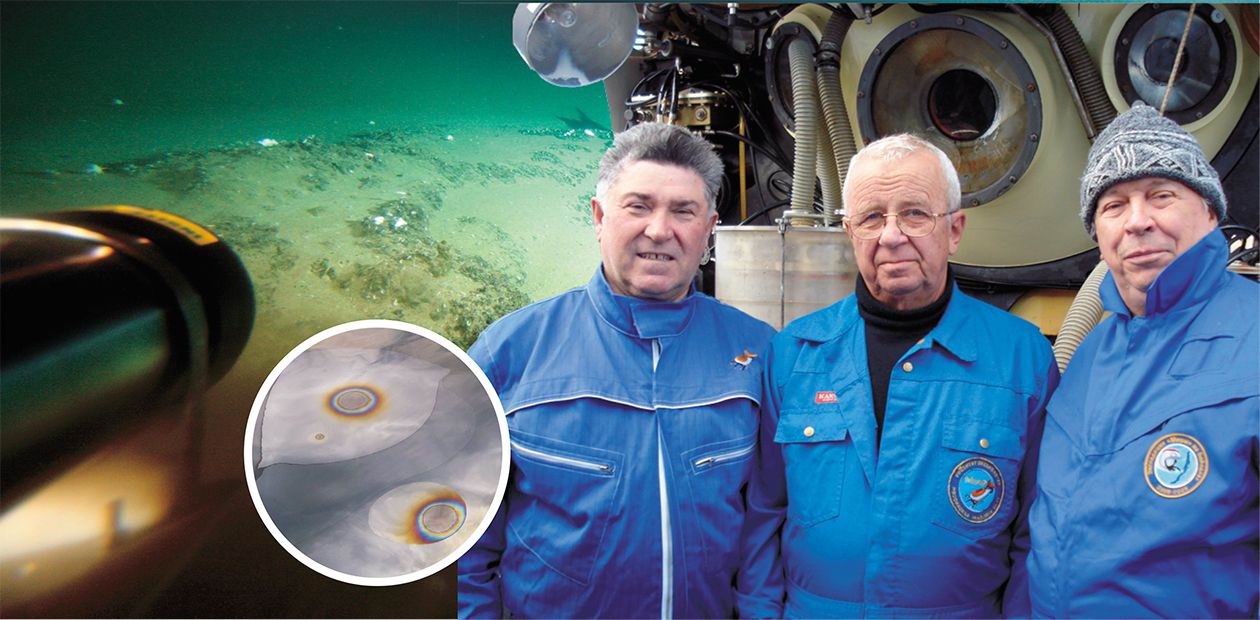Young Оil of Baikal
In recent years several academic institutions have actively studied the oil sampled from the surface and water body of Lake Baikal. In 2008 oil samples were taken from the bottom of the lake for the first time. The nature of the oil has been discussed since the 1930s. The oils were found to contain a unique set of hydrocarbons—biomolecules mostly typical of lipids of organic matter of higher land plants including angiosperms. These plants appeared on the Earth less than 100 million years ago. According to more accurate geological data, the Baikal oil is of Cenozoic age, younger than 65 million years.
Local people have known about oil in the water and on the shore of Baikal from the ancient times. However, it was in the early 18th century that the problem of petroleum potential of the lake and Baikal Rift Zone became the one of science, when the expedition headed by J. G. Gmelin described the oil seepages off the eastern shore. Later, Baikal oil shows were studied by many prominent Russian geologists.
Today there are several hypotheses for the origin of the Baikal oil. In the prewar years (1930s) its source was believed to be Cambrian marine deposits in the eastern part of the lake. Later the majority of geologists suggested the Pre-Cambrian age (more than 540 million years) of the oil source rocks. Other experts linked the oil formation to the Cretaceous or Cenozoic freshwater deposits. Besides, there is a theory of inorganic (mantle) synthesis of the oil.
In the 1980s—1990s a full-scale seismic study was conducted on Baikal, which showed that four sedimentary basins (with the thickness of sediments up to 7.5 km) may be recognized in the Baikal Rift Zone. The presence of oil and gas reservoirs can be inferred from geological and geophysical data. An elevated heat flow has also been recorded in the rift zone, which leads to the heating of sedimentary mass and stimulates the formation of hydrocarbons.
From 2004 to 2006, the expedition on the G. Yu Vereshchagin research vessel studied oil shows at different points of the lake capes. It was determined that from time to time oil comes to the surface in the shape of small spheres up to 1 cm in diameter. In 2008 a group of scientists from the Institute of Oceanology RAS; Limnological Institute SB RAS; Baikal Institute of Nature Management, and Institute of Petroleum Geology and Geophysics SB RAS studied the bottom of Baikal near capes Gorevoyi Utes and Tolstyi in the Mir submersibles. The bottom of the lake was found to be covered with a smooth layer of diatom oozes with paraffin-asphalt “patches” that produce drops of oil.
To solve the problem of genesis of the Baikal oil, we conducted organogeochemical studies of all surface oil shows and samples of hard bitumens from the bottom of Baikal. The very first results showed that the oils are unique in their set of the so-called molecules-biomarkers, that is, polycyclic hydrocarbons, which inherited the primary structures of fossil organic matter. All oils and bitumens contain absolutely identical sets of these biomarkers, confirming their common origin. Data of chromatography-mass spectrometry suggest that the initial organic matter for the Baikal oils was remains of higher vegetation and lake plankton as well as products of bacterial activity. And, more importantly, the biomarkers include pentacyclic oleanan, the hydrocarbon that appeared in oils in the epoch of expansion of angiosperms. Thus, the Baikal oil dates from the Late Cretaceous, or more likely, from the Cenozoic, which means that it is younger than 65 million years.
The oil resources of Baikal are estimated by experts as 500 million tons of conditional hydrocarbons. From time to time the seismic activity renews the fractures in sedimentary cover along which hydrocarbons migrate from pools to water. Annually several tons of oil comes this way, and, paradoxically, it became a stable component of the ecosystem of the lake’s eastern offshore. The area is inhabited by specific communities of bacteria, which use hydrocarbons in their life cycle. The most “delicious” paraffin hydrocarbons are utilized almost completely by the bacteria, that is, the natural oil seepages are not dangerous for Baikal ecology.
Theoretically, deposits of Baikal hydrocarbons might be found. But even with the full-scale exploration they might be ready for use no earlier than in 10—15 years. At the same time, these oil reserves are inferior to the Kovyktinskoe deposit in the Irkutsk oblast, whereas the exploration and operation works can cause great and irrevocable damage. We believe that Baikal oil is just a great chance given to us by Nature with a view to conducting studies of modern oil formation and destruction of pools in continental rift structures.










